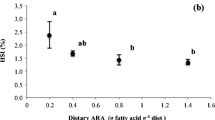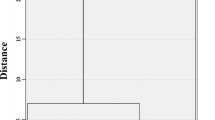Abstract
Effects of dietary α-lipoic acid (LA) and ascorbic acid (AA) on the growth, tissue vitamin C and tocopherol (vitamin E) levels, and malondialdehyde levels were examined in the tropical fish pacu, Piaractus mesopotamicus. Pacu juveniles were fed one of four casein-gelatin-based diets for 8 weeks: with 0.05% AA and 0.1% LA (+AA+LA), with AA and without LA (+AA–LA), without AA and with LA (−AA+LA), and without AA and LA (−AA−LA). When the fish received quantities of feed equal to 1.9–2.5% of its body weight, growth was not influenced, regardless of the presence of AA or LA throughout most of the experimental period. Growth was, however, slightly but significantly lower at week 8 in the AA-deficient/LA-supplemented group. An AA-deficient diet caused a highly significant reduction in both total AA and dehydroascorbic acid content in the liver and gill tissues. This reduction of tissue AA concentrations was reversed in a significant manner by LA (antioxidant-sparing effect). The 8-week-long vitamin C deprivation was sufficient to initiate the reduction in tissue ascorbic acid; however, total ascorbate in the liver of fish in the (−)AA/(+)LA group was 127.7±54.3 nmol g−1 tissue, whereas it was 28.6±26.3 nmol g−1 in the (−)AA/(−)LA group, a 4.4-fold difference. This mitigating effect of the addition of the endogenous antioxidant LA to the diet indicates that LA exerts a vitamin C-sparing effect in teleost fish that by far exceeds the phenomena demonstrated in non-scurvy-prone mammals. There was no difference among the different diet groups for vitamin E and malondialdehyde levels in the liver. These results suggest that LA is a potent substance for the prevention of AA deficiency in cultured fishes. The optimal dietary level of LA needs to be determined in the light of the slight reduction in body weight gain after 8 weeks of feeding in the absence of AA.



Similar content being viewed by others
References
Arai S, Nose T, Hashimoto Y (1972) Qualitative requirements of young eels Anguilla japonica for water soluble vitamins and their deficiency symptoms. Bull Freshw Fish Res Lab 22:69–83
Bast A, Haenen GRMM (1988) Interplay between lipoic acid and glutathione in the protection against microsomal lipid peroxidation. Biochim Biophys Acta 963:558–561
Biewenga G, Ph, Haenen GRMM, Bast A (1997) The pharmacology of the antioxidant lipoic acid. Gen Pharmacol 29:315–331
Busse E, Zimmer G, Schopohl B, Komhuber B (1992) Influence of α-lipoic acid on intracellular glutathione in vitro and in vivo. Arzneim Forsch 42:829–831
Carreau JP (1979) Biosynthesis of lipoic acid via unsaturated fatty acids. Methods Enzymol 62:152–158
Cort WM, Vicente TS, Waysek EH, Williams BD (1983) Vitamin E content of feedstuffs determined by high performance liquid chromatographic fluorescence. J Agric Food Chem 31:1330–1333
Dabrowski K, Hinterleitner S (1989) Simultaneous analysis of ascorbic acid, dehydroascorbic acid and ascorbic sulfate in biological materials. Analyst 114:83–87
Dabrowski K, Hinterleitner S, Sturmbauer C, El-Fiky N, Wieser W (1988) Do carp larvae require vitamin C? Aquaculture 72:295–306
Dabrowski K, El-Fiky N, Kock G, Frigg M, Wieser W (1990) Requirement and utilization of ascorbic acid and ascorbic sulfate in juvenile rainbow trout. Aquaculture 91:317–337
Fracalossi DM, Allen ME, Yuyama LK, Oftedal OT (2001) Ascorbic acid biosynthesis in Amazonian fishes. Aquaculture 192:321–332
Gal EM (1965) Reversal of selective toxicity of (−)-α-lipoic acid by thiamine in thiamine-deficient rats. Nature 207:535
Hagen TM, Ingresoli RT, Lykkesfeldt J, Liu J, Wehr CM, Vinarsky V, Bartholomew JC, Ames BN (1999) (R)-α-Lipoic acid-supplemented old rats have improved mitochondrial function, decreased oxidative damage, and increased metabolic rate. FASEB J 13:411–418
Handelman GJ, Han D, Tritschler HJ, Packer L (1994) Alpha-lipoic acid reduction by mammalian cells to the thiol form, and release into the culture medium. Biochem Pharmacol 47:1725–1730
Halver JE (1972) The role of ascorbic acid in fish disease and tissue repair. Bull Jpn Soc Sci Fish 38:79–92
Halver JE, Smith RR, Tolbert BM, Baker EM (1975) Utilization of ascorbic acid in fish. Ann NY Acad Sci 258:81–102
Herbert AA, Guest JR (1975) Lipoic acid content of Escherichia coli and other microorganisms. Arch Microbiol 106:259–266
Hill AS, Werner JA, Rogers QR, O’Neill SL, Christopher MM (2004) Lipoic acid is 10 times more toxic in cats than reported in humans, dogs or rats. J Anim Physiol Anim Nutr 88:150–156
Jocelyn PC (1967) The standard redox potential of cysteine-cystine from the thiol-disulfide exchange reaction with glutathione and lipoic acid. Eur J Biochem 2:327–331
Kataoka H (1998) Chromatographic analysis of lipoic acid and related compounds. J Chromatogr B 717:247–262
Kim MS, Park JY, Namkoong C, Jang PG, Ryu JW, Song HS, Yun JY, Namgoong IS, Ha J, Park IS, Lee IK, Viollet B, Youn JH, Lee HK, Lee KU (2004) Anti-obesity effects of alpha-lipoic acid mediated by suppression of hypothalamic AMP-activated protein kinase. Nat Med 10:723–733
Kozlov AV, Gille L, Stanick K (1999) Dihydrolipoic acid maintains ubuiquinone in the antioxidant active form by two-electron reduction of ubiquinone and one-electron reduction of ubisemiquinone. Arch Biochem Biophys 363:148–154
Lee KJ, Dabrowski K (2003) Interaction between vitamins C and E affects their tissue concentrations, growth, lipid oxidation, and deficiency symptoms in yellow perch (Perca flavescens). Br J Nutr 89:589–596
Lim C, Lovell RT (1978) Pathology of the vitamin C deficiency syndrome in channel catfish (Ictalurus punctatus). J Nutr 198:1137–1146
Lykkesfeldt J, Hagen TM, Vladimir V, Ames BN (1998) Age-associated decline in ascorbic acid concentration, recycling, and biosynthesis in rat hepatocytes-reversal with (R)-α-lipoic acid supplementation. FASEB J 12:1183–1189
Martin DSD, Towey M, Horrobin DP, Lynch MA (2000) A diet enriched in α-lipoic acid reverses the age-related compromise in antioxidant defence in rat cortical tissues. Nutr Neurosci 3:193–206
Martins ML (1995) Effect of ascorbic acid deficiency on the growth, gill filament lesions and behavior of pacu fry (Piaractus mesopotamicus Holmberg, 12887). Braz J Med Biol Res 28:563–568
Matusiewicz M, Dabrowski K, Volker L, Matusiewicz K (1995) Ascorbate polyphosphate is a bioavailable vitamin C source in juvenile rainbow trout: tissue saturation and compartmentalization. J Nutr 125:3055–3061
Moreau R, Dabrowski K (2001) Gulonolactone oxidase presence in fishes, activity and significance. In: Dabrowski K (eds) Ascorbic acid in aquatic organisms. CRC Press, Boca Raton, pp 13–32
Moron MS, Depierre JW, Mannervik B (1979) Levels of glutathione reductase and glutathione-S-transferase activities in rat lung and liver. Biochim Biophys Acta 582:67–70
Otto DME, Sen CK, Casley WL, Moon TW (1997) Regulation of 3,3′,4,4′-tetrachlorobiphenyl induced cytochrome P450 metabolism by thiols in tissues of rainbow trout. Comp Biochem Physiol C 117:299–309
Packer L, Roy S, Sen CK (1997) Alpha-lipoic acid: a metabolic antioxidant and potential redox modulator of transcription. Adv Pharmacol 38:79–101
Reed LJ (1974) Multienzyme complex. Acc Chem Res 7:40–46
Reed LJ, Florkin M, Stotz EH (eds) (1966) Comprehensive biochemistry, vol 14. Elsevier, New York
Rosenberg HR, Culik R (1959) Effect of α-pipoic acid on vitamin C and vitamin E deficiencies. Arch Biochem Biophys 80:86–93
Shih JCH (1983) Atherosclerosis in Japanese quail and the effect of lipoic acid. Fed Proc 42:2494–2497
Soliman AK, Jauncey K, Roberts RJ (1986) The effect of varying forms of dietary ascorbic acid on the nutrition of juvenile tilapias (Oreochromis niloticus). Aquaculture 52:1–10
Stickney RR, McGeachin RB, Lewis DH, Mazkz J, Riggs A, Sis RP, Robinson EH, Wurtz W (1984) Responses of Tilapia aureus to dietary vitamin C. J World Maricult Soc 15:179–185
Suh JH, Shigento ET, Morrow JD, Cox B, Rocha AE, Frei B, Hagen TM (2001) Oxidative stress in the ageing rat heart is reversed by dietary supplementation with (R)-α-lipoic acid. FASEB J 15:700–706
Tatum VL, Changchit C, Chow CK (1990) Measurement of malondialdehyde by high performance liquid chromatography with fluorescence detection. Lipids 25:226–229
Teichert J, Preiss R (1995) Determination of lipoic acid by high-performance liquid chromatography with electrochemical detection. J Chromatogr B 672:277–281
Terjesen BF, Park K, Tesser MB, Portella MC, Zhang Y, Dabrowski K, (2004) Lipoic acid and ascorbic acid affect plasma free amino acids selectively in the teleost fish pacu (Piaractus mesopotamicus). J Nutr 134:2930–2934
Tesser MB, Terjesen BF, Zhang Y, Portella MC, Dabrowski K (2005) Free- and peptide-based dietary arginine supplementation for South American fish pacu (Piaractus mesopotamicus). Aquacult Nutr 11:443–453
Vasdev S, Ford CA, Parai S, Longerich L, Gadag V (2000) Dietary α-lipoic acid supplementation lowers blood pressure in spontaneously hypertensive rats. J Hypertens 18:567–573
Wollin SD, Wang Y, Kubow S, Jones PJH (2005) Effects of medium chain triglycerides oil mixture and lipoic acid diet on body composition, antioxidant status, and plasma lpid levels in the Golden Syrian hamster. J Nutr Biochem 15:402–410
Yilmaz O, Ozkan Y, Yildirim M, Ozturk AI, Ersan Y (2002) Effects of lipoic acid, ascorbic acid-6-palmitate, and fish oil on the glutathione, malondialdehyde, and fatty acids levels in erythrocytes of streptozotocin induced diabetic male rats. J Cell Biochem 86:530–539
Zaspel BJ, Csallaany AS (1983) Determination of α-tocopherol in tissues and plasma by high-performance liquid chromatography. Anal Biochem 130:145–150
Ziegler D, Nowak H, Kempler P, Vargha P, Low PA (2004) Treatment of symptomatic diabetic polyneuropathy with the antioxidant α-lipoic acid: a meta-analysis. Diabet Med 21:114–121
Acknowledgements
This research was in part supported by the Kunsan National University (South Korea) Longterm Overseas Research Program for Faculty Members in the year 2003. This work was a component of the Pond Dynamics/Aquaculture Collaborative Research Support Program (PD/A CRSP) supported by the US Agency for International Development, Grant No. RD010A-12 (KD) (accession no. 1306) and by the FAPESP grant (00/07314-0) and CNPq (project No. 477812/03-1) (MCP).
Author information
Authors and Affiliations
Corresponding author
Rights and permissions
About this article
Cite this article
Park, K.H., Terjesen, B.F., Tesser, M.B. et al. α-Lipoic acid-enrichment partially reverses tissue ascorbic acid depletion in pacu (Piaractus mesopotamicus) fed vitamin C-devoid diets. Fish Physiol Biochem 32, 329–338 (2006). https://doi.org/10.1007/s10695-006-9110-9
Received:
Accepted:
Published:
Issue Date:
DOI: https://doi.org/10.1007/s10695-006-9110-9




